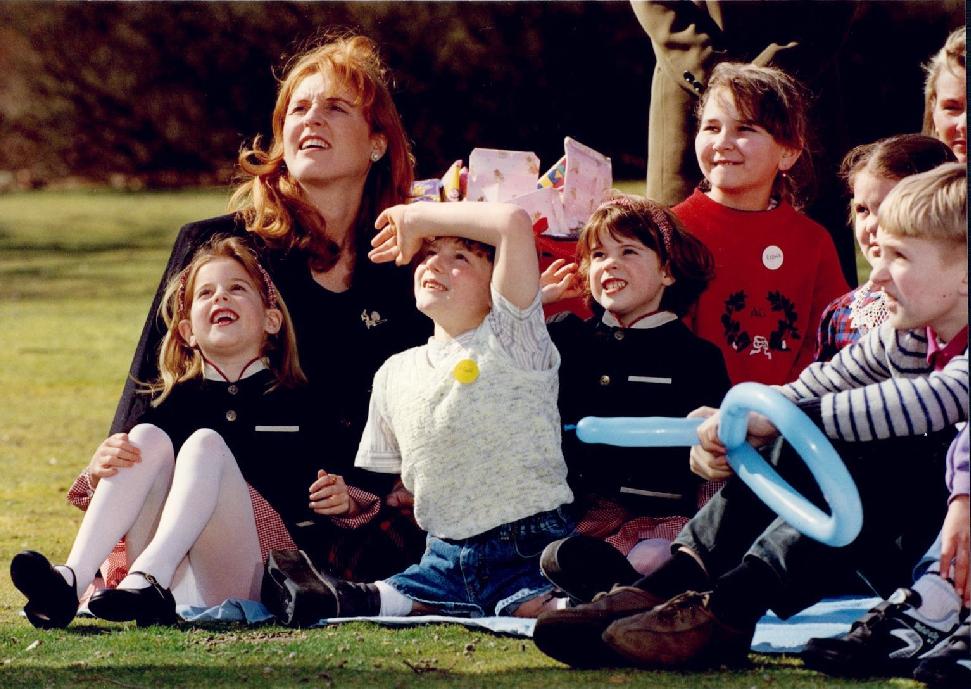
The Cold War: Soviet Union -- Chernobyl (April 1986)

Figure 1.--The poorly designed Soviet nuclear reactor at Chernobyl exploded (April 26, 1986). Despite Gorbachev's brave new reforms, old habits die hard. The Soviet officials despite the health dangers of radiation exposure to people living close to the reactior, the Soviet Governmeny made no public anouncement or issued health advisories to the Soviet people or to neighboring countries. Here some Chernobyl children are being hosted by a British charity. The press caption read, "Now we are five it's time to juggle our way into the sptlight: It looked easy enough. So when the clown asked who wanted to try theur hand at juggling, Princess Eugenie stepped forward. Things proved a little trickier. Than she imagined, however -- even for a girl celebrating her fifth birthday. The Queen's youngest grandchild did her best to grasp the concept but dissolved into a fot of giggles as the coloured balls bounced on to the grass. Her audience didn't mind. Big sister Beatrice led the applause, long with their mother the Duchess of York and a group of youngsters brought to England by a charity. The sunshine-filled grounds of the Royal Bershire Hotel in Ascot, where the fun took place yesterday, were a world away from the grey reality awaiting them in Russia. But they will go home smiling at the memory of their own Royal Command Performance."
|
|
The poorly designed Soviet nuclear reactor at Chernobyl exploded (April 26, 1986). Chernobyl is located in the Ukraine, about 90 kilometres (56 mi) northeast of Kiev near the Belarus border. Brave efforts were made to salvage the sitution. Several workers at the plant were true heroes. They exposed themselves to lethal doses of radition trying to prevent a nuclear explosion. Government officials reacted very differently. Despite Gorbachev's brave new reforms, old Soviet habits die hard. The Soviet officials despite the health dangers of radiation exposure to people living close to the reactior, the Soviet Governmeny made no public anouncement or issued health advisories to the Soviet people or to neighboring countries. This disaster was not, however, something that could be covered up behind closed Soviet borders. Soon officials in Western Europe, first in Sweden, began reporting high levels of radioactivity that was eminating from somewhere from the Soviet Ukraine. Soviet officials did not provide a full account of the Chernobyl accident until weeks after the accident--May 14. Finally Gorbachev appeared on television speaking to the Soviet people. Many in the West questioned his real commitment to Glasnost. The address itself, however, was a milestone in how Soviet leaders communicated such matters to their people. Even so, the truth about Chernobyl did not emerge until years after the disaster. There were design faults at the reactor, but this is not what caused the disaster. It occured because of the Cold War mentality of Soviet officials. A group of engineers were running a full-power test late at night. Because of the time, the head supervisers were not there. The lower-level personnel did not know that the facility included a secret operation to produce weapons-grade plutonium. The enginners were thus not aware that the release of energy would far exceed design specifucations because they did not include the plutonium operation in their calculations. When the reactor went critical, the engineers who were unaware of the secret plutonium operation had no way of bringing the reactor under control. [Birkhofer] The radiation released spread over a wide area of Western Europe. Belarus and Ukraine were especially affected. The accident released radiation 200 times greater than that released by both American atomic bombs dropped on the Japanese cities of Hiroshima and Nagasaki. Notice how much discussion of those World War II incidents continues, but how little we hear about Chernobyl today. The children of Ukraine and Belarus are paying a terrible price. This is espcially the case pf the children born with birth defects and the lack of care they receive. A tragic example is Belarus boy Igor Pavlovets. Few of these children receive prosthetics in the Russian/Ukranian/Belarus institutions caring for them.
Sources
Birkhofer, Adolph. Technical Universi=ty of Munich. University of Pittsburgh Conference on Nuclear Power (2012).
CIH -- Cold War

Navigate the CIH Cold War Section:
[Return to Main Reagan-Gorbechov page]
[Return to Main Soviet Cold War page]
[Return to Main Cold War European country page]
[Return to Main Cold War country page]
[Return to Main Cold War page]
[Return to Main Communism page]
[About Us]
[Assessment]
[Biogrphies]
[Countries]
[Communism]
[Culture]
[Decolonization]
[Economics]
[Famines]
[Fashion]
[Freedom]
[Hot wars]
[Human rights]
[Inteligence]
[Mass killing]
[Military]
[Pacifism]
[Phases]
[Science]
[Totalitarianism]
[Bibliographies]
[Contributions]
[FAQs]
[Images]
[Links]
[Registration]
[Tools]
[Return to the Cold War Home page]
[Return to the 20th century wars and crises]
Created: 11:30 PM 11/10/2017
Last updated: 8:39 AM 2/20/2019



